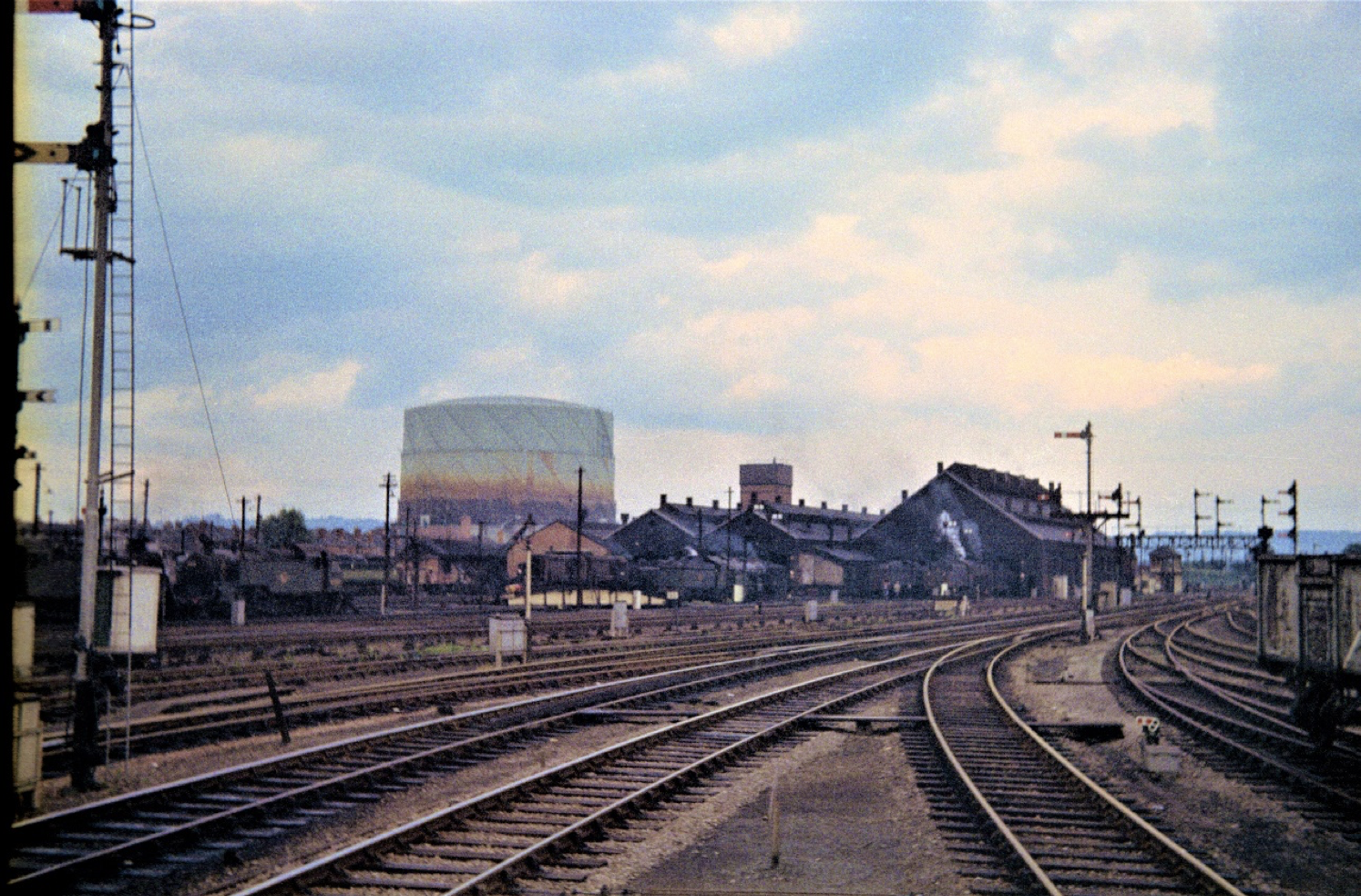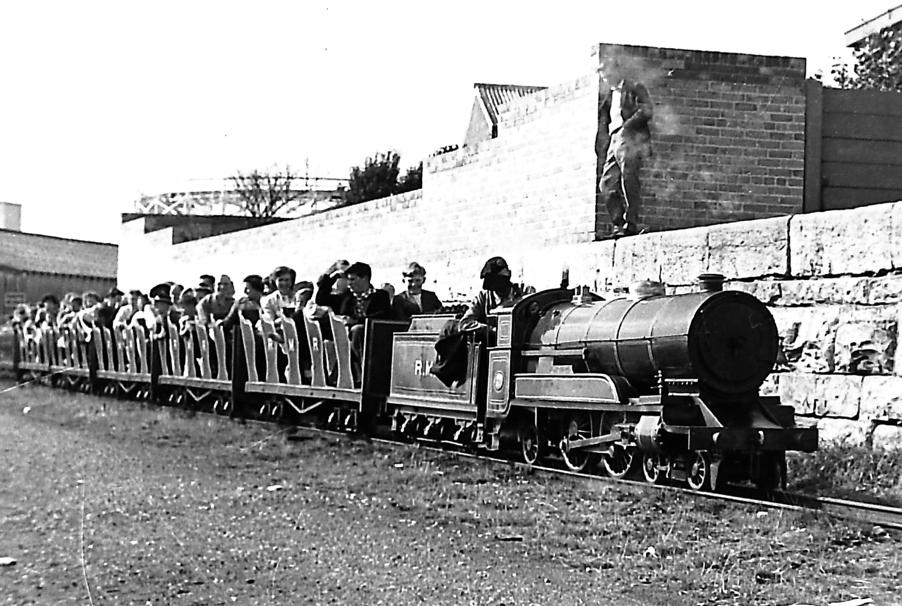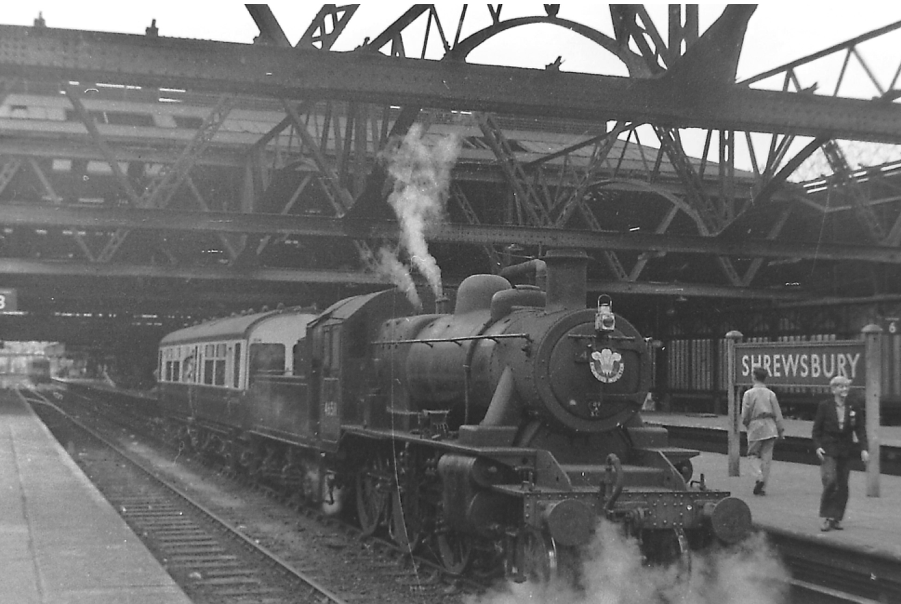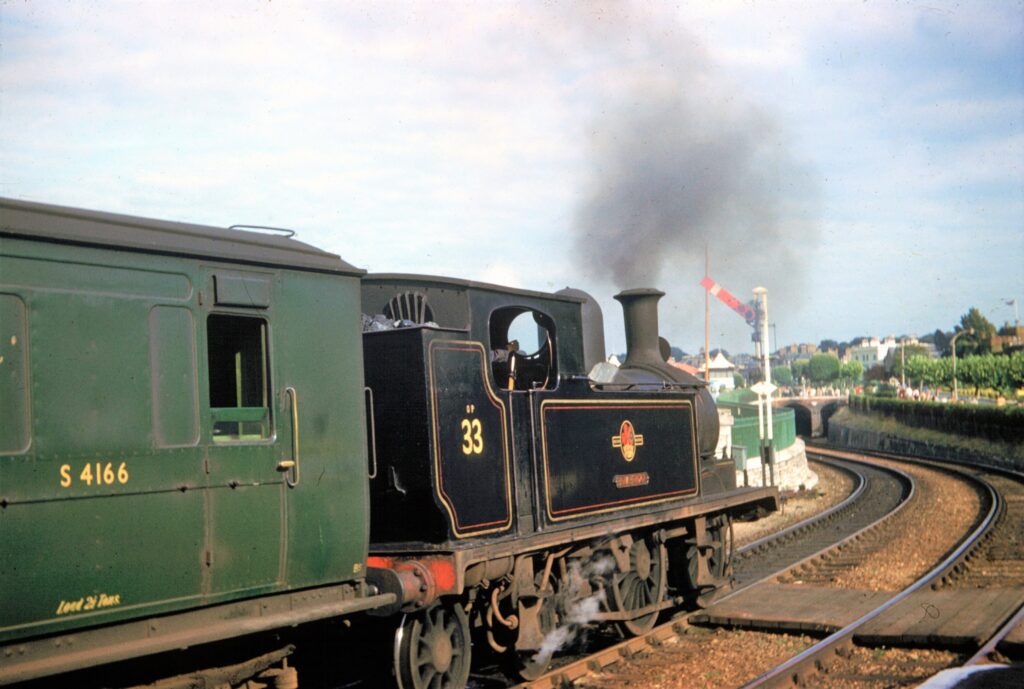Family Holidays
1955 – Torquay
Our first summer proper family holiday was to Torquay by train. I was dressed in a new blazer, to impress the Londoners who came down in their cars. We stayed in an elegant flatlet, Kathleen Court in appropriately named Stitchhill Road, high up in hilly Babbacombe. Whilst it was easy to walk down to the front, we preferred to catch the 111 bus back up from the harbour.
We travelled out on the four-track section past the prefab in Fourth Avenue where we had lived up to 1951, on the 9.00am (6.35am ex-Walsall) to Paignton, a 21A ‘Black 5’ duty. Races were quite common along this section, and we diced with ‘Hall’ 4-6-0 No. 4954 Plaish Hall, in black with red nameplates and a Hawksworth tender. Trains were packed then, so that we had to stand all the way to Taunton in an old GW coach with a door to every compartment. In fact, we only got a seat at Taunton by arguing with a family who had got into the compartment through the opposite door!
The most interesting sights at Exeter St Davids were the 72A ‘WC’ class Pacifics arriving on parts of the up ‘Atlantic Coast Express’ (No. 34069 Hawkinge seemed to be a regular performer); the E1/R class 0-6-2T bankers (Nos. 32124/35, 32695/7) waiting to assist trains up the bank to Central (these were being replaced by ‘Z’ class 0-8-0Ts by August 1959); and ‘T9s’ on locals. Then we traversed that famous section along the sea wall between Dawlish Warren and Teignmouth before running alongside the Teign estuary to that great railway centre Newton Abbot, which then had its own railway works.
Probably the most memorable trip during the holiday was to Plymouth over the South Devon banks, behind ‘Hall’ No. 6938 Corndean Hall and ‘Britannia’ No. 70019 Lightning. We also travelled into Cornwall behind a ‘6400’ 0-6-0PT hauled auto-train over the Tamar Bridge. The parallel Southern system was still in use, and a couple of Friary ‘M7’ 0-4-4Ts were seen.
For our journey home, seat regulation tickets were needed, such was the demand for travel on Summer Saturdays then. We failed to get them for the ‘Devonian’, so we were allocated to the 11.10am Paignton – Nottingham due in Gloucester at about 3.0pm. Torquay station instituted a queuing system on the station forecourt to deal with the volumes of boarding passengers, releasing returning holidaymakers onto the platform as each train was due.
1958 – Rhyl
In summer 1958 our family went away for a week to Rhyl, staying at a holiday flatlet in Butterton Road. Dad had been at Prestatyn in the Army, and so he wanted to come back the area. This was my first chance to travel behind big LMS steam. We left New Street on 30 August on the morning train to Glasgow. 14 coaches were brought in by ‘Royal Scot’ No. 46143 The South Staffordshire Regiment (5A) from the Wolverhampton direction (probably being stowed at Soho/Monument Lane), which confused me somewhat, as our train started off in the wrong direction towards London! The cold ‘Scot’ slipped and struggled through the tunnels with its heavy train, but had got going by Aston, and thus I was treated to a trip along the Grand Junction line to Wolverhampton past the yards and sheds at Bescot (3A), where ‘Duck 8s’ and Midland ‘2F’ 0-6-0s could be seen. This was long before the M6 had been thought of, of course!
We changed at Crewe into a stopping train to Chester hauled by ‘Black 5’ No. 44763. On passing Crewe works a high wall meant that only the tops of locos could be seen. However, I caught a glimpse of L&Y 0-6-0ST No. 51444 on works duty, as well as L&Y and Midland 0-6-0s. From Chester, we caught another local to Rhyl hauled by No. 80045, a member of the Standard ‘4’ 2-6-4Ts which worked many of the local trains along the North Wales coast. At Shotton, two ‘J72s’ (Nos. 68714/27) from the ex-Great Central line were shunting in the yards adjacent to the steelworks. They were allocated to Bidston (6F) but by August 1959 were in store. We busied along the shores of the Dee estuary, passing Courtaulds factory at Greenfield, and Point of Ayr colliery. On the four-track section beyond Mostyn, we raced with a ‘Black 5’, No. 45057 on the down fast line.
I made a visit to the station on Sunday. Rhyl (6K) MPD was visible from the end of the platform (it later became the Crosville bus depot) and contained Stanier ‘3’ 2-6-2Ts (quite common on the North Wales coast), and old 0-6-0 refugees from the Midland (No. 58293) and the L&Y (No. 52119). A ‘2P’ 4-4-0 (No. 40589) was still in use. Dad said that the ‘Irish Mail’ came through at about 1am and 1pm every day. Holyhead (6J) had some ‘Scots’ allocated to it to power this train, and true to form ‘Scot’ No. 46152 The King’s Dragoon Guardsman took the fast line through the station at lunchtime. I also saw day excursions arriving from Manchester, the Potteries, and Birmingham. They were often new DMU sets, including Metro-Cammell sets from the Lichfield line, and Gloucester RC&WCo units from the Potteries. Local trains in the Llandudno area had already been dieselised using the original Derby lightweight stock in the M79000 series.
On Tuesday 2 September we took a short trip to Llandudno behind ‘Black 5’ No. 45420. The main sight of the day was ‘Scot’ No. 46127 Old Contemptibles, but more of 6K’s L&Y 0-6-0s were observed (Nos. 52162, 52432). At Llandudno, one of the treats was a ride on the precipitous Great Orme Railway, where I noted cars 4 to 7 inclusive.
On Wednesday we went back to Chester, and saw ‘Castle’ No. 5012 Berry Pomeroy Castle, ‘County’ No. 1017 County of Hereford, ‘Britannia’ No. 70048 and Standard ‘5’ No. 73092 (a loco destined to end up at Gloucester!). My parents bought me a Kodak Box-Brownie camera for my birthday so that I could take train photos. This replaced my Coronet camera that took square-format (120) photographs. On Friday a visit to the pleasure beach gave the opportunity for a ride on the delightful miniature railway, a 15-inch gauge system, powered by three beautiful red Atlantics (101 Joan, 103 John, and 105 Michael); 2-cylinder coal-fired locos, built at Foryd works, Rhyl in 1920. Two others, Billy (106) and Nigel also formed part of the fleet. Rhyl Miniature Railway ran for the last time in 1969.
One of the Rhyl Miniature Railway’s elegant Atlantic locomotives takes a full load of day-trippers round the Marine Lake on 1 August 1960.
Finally, the trip home. A through train to Birmingham took the freight avoiding line at Crewe, which dived under the main lines bypassing the Station, and so I did not see much, although we must have passed close to Crewe South shed. I did record some interesting locos though. As well as some Johnson ‘2F’ 0-6-0s, I saw ‘Patriots’ Nos. 45511 Isle of Man and 45538 Giggleswick, and ‘Scots’ Nos. 46118 Royal Welch Fusilier and 46150 The Life Guardsman. I did not know at the time, but this would be our last holiday as a complete family, as my father died just before Christmas that year.
1960 – Shrewsbury
On 18 August we had a family trip by service train via Hereford to Shrewsbury as mum wanted to visit the Floral Fete. I spent my time at the station. The LMS interest was provided by the possibility that something spectacular would turn up from Crewe – after all I had seen photos of ‘Duchesses’ running in here. The Cambrian line also held possibilities for rare GW engines, but trains on the line to Welshpool were few and far between, and it was quite likely that an 84G engine rather than an 89C one would turn up. An afternoon spent at the station did not provide any surprises, although I did get a photo of Ivatt ‘2’ 2-6-0 No. 46511 working an Engineer’s inspection saloon.
Ivatt ‘2’ 2-6-0 No. 46511 (89A) sporting a fleur-de-lys headboard simmers at the head of an Engineer’s Inspection Saloon at Shrewsbury on 18 August 1960 after arrival from the Chester line.
1961 – Portsmouth
In 1961 mum took us children on holiday to Portsmouth for a week, staying in a flatlet on the main trolley-bus route north through Fratton. On 19 August we caught a connecting train to Bristol, before taking the 10.50am to Portsmouth Harbour, due there at 2.09pm. Up to 1962 these services were regularly hauled by Bath Road ‘Counties’ as far as Salisbury, and I particularly remember the bark from our ‘County’s’ double chimney as it swung around the bends along the incised valley of the Avon between Bathampton and Bradford-on-Avon. At Salisbury, a Southern ‘U’ class 2-6-0 took over, which was no mean slouch either and had steady feet as it pulled away from Romsey [flash forward to one starting away from Surbiton on an up stopper]. We were stopped outside Eastleigh on the curve before getting the right of way and pulling through the station alongside the works. Here I saw some locos new to me, including ‘O2’ No. 30192. After a halt outside Fareham, which seemed an important junction, I noted No. 32646, an immaculate A1X ‘Terrier’ 0-6-0T simmering in a siding on its way to relieve the Hayling Island branch loco. The main route took a sharp left-hand curve away from Fareham. Where did the ‘main’ straight-on line go? Only to Gosport. We then ran parallel to the ridge of the South Downs, with the radio station at Portsdown prominent on the left, whilst to the right was the coast with the hammerhead cranes of the Dockyard Harbour and the tower of Guildhall in the distance. At Hilsea Halt we joined the electrified lines, after waiting for several Waterloo and Brighton line trains to pass. Fratton MPD was inhabited by one of the ‘K’ 2-6-0s, No. 32346, another class I had not seen before. These elegant locos were one of the most successful designs of the old LBSC railway, and all survived until the end of 1962, when the whole class were withdrawn to reduce the number old steam locomotives on SR books.
We took a taxi from Portsmouth & Southsea station to our accommodation which was in fact nearer Fratton. On Sunday we went with mum to high church. I remember especially the maroon trolleybuses adorned with the city’s coat of arms (a star above a crescent moon), and the TIM ticket machines with a dial like a telephone. If I remember rightly, they ran the trunk route 18 along the Fratton Road to Southsea Common, the batch being 301-15 (reg nos. ERV926, etc.) Sadly, the last trolleybus in Portsmouth ran in 1963. The Corporation also ran an open-top sea-front service operated by some old Leyland Titan TD4s dating from 1935. Longer distance routes were run by full-frontal green and cream Southdown double-deckers (Leyland PD2s) which always seemed much larger than the Bristol buses at home.
On my birthday (Monday) I had a day trip on my own by Southern electric (2-HAL/BIL units) to Brighton (10/6d return). ‘Terriers’ were seen at Havant, another at Lancing Carriage Works (DS680), and one on Brighton shed. Members of ‘E4’, ‘K’ and ‘Q’ classes were around the Brighton area, along with Standard ‘4’ 2-6-4Ts. I also noted ‘Schools’ 4-4-0 No. 30911 Dover, ‘WC’ Pacifics Nos. 34008/68/101 (all 75A locos), and a ‘C’ class 0-6-0, No. 31724.
On Tuesday we took a boat-trip to Spithead to view the warships and ocean liners on Southampton Water, and oil tankers at Fawley. I took some slides of liners, but unfortunately, they have been lost. The table below notes the salient details of some of the liners seen:
|
Ship |
Line |
Tonnage |
|
SS America |
United States Line |
33,900 |
|
SS Chusan |
P & O Orient Line |
24,215 |
|
SS United States |
United States Line |
51,980 |
|
SS Athlone Castle |
Union Castle Line |
25,564 |
|
RMS Queen Mary |
Cunard Line |
81,237 |
|
SS Flandre |
French Line |
20,469 |
‘O2’ 0-4-4T No. 33 Bembridge pulls away from Ryde Esplanade with the 5.5pm to Ventnor on 23 August 1961.
On Wednesday 23 I made my first visit to the Isle of Wight. From Southsea Common the spire of the church on the hill above Ryde could be seen, and the exhaust of the steam locos on the Pierhead. BR then had several paddle-steamers. We crossed from Southsea to Ryde, and there caught a train to Ventnor behind one of the ubiquitous ‘O2s’.
Our Friday trip was to Eastleigh and Southampton: a spotting trip of which I do not recall too much, apart from the train rushing down to the estuary at Burlesdon. Interesting locos seen included ‘King Arthur’ Nos. 30770/3/82, ‘LN’ Nos. 30860/3, ‘Schools’ No. 30918, ‘W’ 2-6-4Ts, Nos. 31913/22, Standard ‘2’ 2-6-2T No. 84028, and No. WD600, from the Longmoor Military Railway.
We travelled home on 26 August behind ‘U’ 2-6-0 No. 31791 as far as Salisbury, seeing ‘King Arthur’ No. 30796 Sir Dodinas le Savage on the way. Most unusually, the same loco had been recorded earlier on 19 April on Bristol Bath Road depot.



